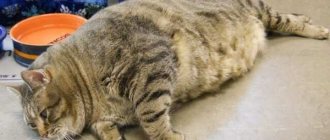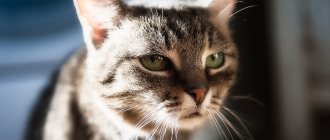Hypertension or hypertension in cats is an abnormal increase in systemic blood pressure. This is a diagnosis that can lead to complications of existing diseases. It is also fatal if left untreated. Hypertension in cats is more common in older age. The average age of patients is 15 years.
Secondary arterial hypertension is the most common condition in cats. It is usually associated with acute and chronic renal failure and hyperthyroidism. Less commonly, it may be associated with hyperaldosteronism or pheochromocytoma. Other types of feline hypertension are idiopathic hypertension and white coat hypertension. This is the name for the increase in blood pressure at the time it is measured during examination, as a result of the animal’s excitement and anxiety.
Sustained hypertension can lead to target organ damage. These are the kidneys, eyes, nervous and cardiovascular systems.
"The Silent Killer": Basics
In human medicine, this name has taken root. In humans, hypertension is often asymptomatic, but causes irreparable harm to the body, “quietly” destroying it from the inside. In veterinary medicine, the situation is different; arterial hypertension in cats (AH) is diagnosed by the appearance of symptoms of severe lesions.
A. Intense papery retinal detachment. b. Retinal detachment and numerous small hemorrhages in the retina, c. Hyphema.
Fact! Hypertension in animals is often not diagnosed at an early stage due to negligence in routine examinations, when blood pressure measurement is neglected. The tonometer is taken when obvious symptoms of systemic hypertension appear.
The disease is detected when the end organs are affected, most often the eyes, when the cat becomes completely blind. Develops in aging animals; pets with CRF (chronic renal failure) are at risk. Measuring blood pressure is a non-invasive examination, but it happens that hypertension develops from fear.
As the drug of choice in the treatment of cats with hypertension, preference is given to Amlodipine, which blocks calcium channels.
High pressure features
Secondary hypertension in cats can develop against the background of serious pathologies, such as:
- diabetes;
- heart failure;
- endocrinological disorders (hyperthyroidism);
- Cushing's disease (increased synthesis of adrenal hormone);
- jades.
Pressure that lasts for a long time has a detrimental effect on the condition of the eyes. In addition, the walls of blood vessels are damaged and blood viscosity increases. A decrease in blood flow causes a decrease in the rate of metabolic processes in tissues. All this is fraught with serious consequences for the body. Therefore, during each routine preventive examination of your pet, it is necessary to measure the pressure.
It is also very important to periodically measure the a/d of individuals who are already 5-7 years old. At this age, animals become susceptible to primary hypertension.
Clinical signs of hypertension
There are no primary signs, or they are mild, so breeders contact a veterinary clinic in case of extensive systemic lesions. More often this is blindness, impaired functioning of the brain and the development of neurological symptoms, heart disease, kidney disease, epistaxis (nosebleeds).
- Visual impairment.
Blindness develops, hemorrhage in the anterior chamber of the eye (hyphema) is diagnosed, the pupils dilate (mydriasis), and there are dark foci of degeneration. During examination, hemorrhage affects the vitreous body, retina, and adjacent tissues; serous retinal detachment is often noted. The lesion affects both eyes, but the nature of the manifestation of the pathology may be different.
Glaucoma and retinal atrophy are secondary changes that are a consequence of hypertension.
Changes in the organs of vision in cats are presented as “hypertensive retinopathy”, but in reality the process affects the vascular layer, there is a release of intraocular fluid and its accumulation in the subretinal space (result, retinal detachment). Irreversible changes in the pigment epithelium occur with ischemia of the choroid.
A. Foci of hemorrhage in the retina. b. Small areas of bullous retinal detachment. V. Small areas of bullous detachment and areas of retinal degeneration.
- Neurological signs.
With hypertension in cats, the following symptoms appear: ataxia, loss of orientation in space, weakness. Violation of the vestibular apparatus is accompanied by paraparesis, characteristic flexion of the neck, stupor, convulsive phenomena and death.
Despite the obviousness of the symptoms, hypertension cannot be diagnosed by neurological signs due to their similarity with other pathologies or euthanasia according to indications, even before the diagnosis is made due to the serious, incurable condition of the pet.
With eye damage and sudden blindness, neurological disorders manifest themselves in the form of depression.
- Vascular changes.
On auscultation in cats with hypertension, a gallop rhythm, systolic and diastolic murmurs are heard. Diagnosed: shortness of breath, tachycardia, arrhythmia.
However, these symptoms also occur in aging cats who do not have blood pressure problems. Confirmation of the diagnosis requires mandatory measurement of blood pressure.
Signs of congestive heart failure appear when hypertension aggravates an existing disease associated with the cardiovascular system. But hypertension itself is not a factor provoking heart failure.
X-ray examination reveals an enlargement of the left ventricle and the heart as a whole, and undulation of the thoracic aorta. The ECHO image “sees” mild left ventricular hypertrophy of the wall and interventricular septum. Often the size of the heart in hypertension remains normal.
What can cause high blood pressure?
Arterial hypertension in cats is diagnosed when blood pressure exceeds 150/95-110 mm Hg. Art. In this case, the animal is closely monitored and data is regularly recorded. If the values fluctuate at 160/120, complex drug therapy is urgently prescribed. A blood pressure of 180/120 is considered critical. With such indicators, a hypertensive crisis can occur at any time. In this case, the cat is hospitalized and given emergency care. Based on etiology, there are systemic, secondary and pulmonary hypertension in cats.
Common causes of high blood pressure in cats are:
Indicators may be elevated in animals suffering from diabetes.
- cardiac and vascular pathologies;
- kidney and adrenal dysfunction;
- dysfunction of the thyroid gland;
- progression of systemic pathologies, for example, diabetes.
Portal hypertension, in which high pressure is recorded in the portal veins, can be caused by the following pathologies:
- thrombosis of large vessels;
- splenomegaly;
- hepatitis of various types;
- cirrhosis or fibrosis of the liver;
- cardiovascular diseases.
Hypertension due to fear
The development of symptoms is similar to the “white coat effect” in medicine, when a person’s blood pressure rises as soon as he crosses the threshold of the doctor’s office. The veterinarian should always take into account the existing phenomenon of a short-term jump in readings, no matter how simple the method of measuring blood pressure.
Ignoring the moment leads to incorrect diagnosis and subsequent ineffective treatment. It is impossible to attribute elevated blood pressure to this phenomenon. What to do? When visiting a veterinary clinic, give your cat time to adapt, allowing him to get used to the environment and the doctor's touch. Of course, if the visit is not related to emergency assistance.
The concept of blood pressure, rules for its measurement, normal indicators
Blood pressure is calculated in mmHg. (millimeters of mercury) and consists of two digits separated by a fraction. The first number is an indicator of the level of pressure with which the blood presses on the walls of blood vessels at the moment when the heart contracts. This state is called systole, and the pressure is called systolic. The second indicator is the level of blood pressure in the vessels at the moment of cardiac relaxation or diastole. The indicator is called diastolic. The level of general blood pressure directly depends on the condition of the walls of blood vessels, their physiological resistance, as well as the frequency of the heart.
The normal blood pressure for a cat is: 120±16/80±14, i.e. on average, the level of 120/80 is considered normal, just like in humans.
Methods for measuring blood pressure
- oscillometric;
- Dopplerography;
- ultrasonic;
- photoplethysmographic;
- direct (or invasive).
Most often, a cat's blood pressure is measured oscillometrically using a regular veterinary or digital tonometer. This is the safest and most accurate method for determining blood pressure status.
A special tonometer cuff is placed on the paw or tail (depending on the condition of the animal and its size), which is connected to a special digital unit and a compressor or bulb to pump air. The pulse oscillation enters the digital unit and at the end the finished pressure value (systolic and diastolic) is issued.
Measurements are carried out several times, because During the procedure, it is sometimes very difficult to achieve calmness in the animal, and increased mobility and anxiety are sure to affect the final results.
The direct (invasive) method by catheterization of a peripheral artery is used extremely rarely, although it is considered the “gold standard”. The method requires invasiveness (introduction into body tissue) and additional sedation of the animal (putting it into a semi-asleep state to reduce motor activity).
Dopplerography, ultrasound and photoplethysmography methods can only be used with appropriate technical equipment in veterinary clinics, and therefore are used infrequently. Also, these procedures have their own cost.
How to diagnose hypertension in a cat?
Pressure control is carried out by direct and indirect methods. The first are considered the “gold standard” and are performed using artery puncture and catheter. But they are not suitable for routine testing; blood pressure increases as a reaction to pain and stress. There is a chance of infection, causing the development of thrombosis and hemorrhage.
As an experiment, the introduction of special intravascular sensors is used, but they have not found widespread use in veterinary medicine.
List of available techniques:
- Oscillometric (air-filled cuff).
- Doppler (ultrasonic signal sensor of red blood cells).
Indirect methods of measuring blood pressure are considered acceptable in any animal examination setting.
Blood pressure is measured on the tail, front, and hind paws.
Criteria for hypertension
There are no clear indicators that allow you to diagnose hypertension in a cat absolutely. This is explained by the lack of research conducted. It has been established that in cats, a critical complication of hypertension is damage to the visual organs.
High Blood Pressure in Cats
Cats don't smoke, don't eat excessive amounts of salt, and their lives are generally calm and stress-free, so why should we worry about their blood pressure? For a long time, most veterinarians did not know or even imagine that cats could have high blood pressure or hypertension, and they did not know how to measure this pressure. Subtle, barely noticeable signs that indicate high blood pressure in a cat are more frequent and loud meowing during the day and a “woozy”, sleepy state of your pet, as if she is under the influence of alcohol.
Veterinarians now know from extensive testing that high blood pressure is quite common in older cats and, fortunately, is highly treatable. Measuring a cat's blood pressure and obtaining accurate and reliable data is quite difficult, because very few animals remain completely calm and relaxed when visiting a veterinarian. There are several types of instruments used to measure blood pressure, but they all have a cuff placed on the patient's leg and a mechanism to determine when blood may be flowing through partially compressed blood vessels. It is necessary to take 3-5 measurements to accurately estimate the value of systolic blood pressure. When systolic pressure is above 180, there is a high risk of damage to organs and tissues.
High blood pressure causes problems with the heart and with blood circulation throughout the body. In cats, one of the main organs affected by high blood pressure is the eyes. Tiny blood vessels in the eye can burst when there is too much pressure on them. When this happens, retinal detachments and hemorrhages begin, and blindness can occur. If an owner immediately notices sudden blindness in a cat and the cat is diagnosed with high blood pressure, immediate treatment may result in the restoration of vision. If high blood pressure is not treated within a few days, the chances of the retina healing and vision being restored are extremely low.
Most people develop hypertension without a specific medical problem. In cats, high blood pressure is always a secondary condition to chronic kidney disease. hyperthyroidism (hyperthyroidism) or diabetes. If you have a cat suffering from these diseases, you should check its blood pressure at least 1-2 times a year. If your cat is diagnosed with arterial hypertension, it is important to do all the necessary tests and undergo an examination to find possible causes and the underlying disease.
The initial drug used to treat high blood pressure in cats is amlodipine. It is produced in tablet form for humans and is very difficult to cut into smaller doses, so it is recommended to purchase a special tablet cutter for more accurate dosing. Amlodipine is a calcium channel blocker. Cats usually need to take it orally (by mouth) once or twice a day. If amlodipine does not help lower blood pressure, other drugs are added.
Unfortunately, studies have not shown a significant effect of diet on a cat's blood pressure, but diets for older cats, like those for cats with kidney disease, tend to be lower in sodium and are also recommended for hypertension. Blood pressure usually stabilizes within 1-2 weeks of treatment, but cats almost always require ongoing treatment for the rest of their lives. The exception is high blood pressure caused by hyperthyroidism; if this disease is eliminated, the pressure will normalize.
It is helpful for owners to know how cats develop hypertension. Blood pressure testing should be an integral part of regular veterinary visits for older cats and for young cats with suspicious clinical signs (symptoms).
Treatment of hypertension in cats and prognosis
Once the diagnosis is confirmed, therapy proceeds in two directions: blood pressure is reduced with the help of antihypertensive drugs (amplodipine, benazepril). The second step is treatment of the underlying disease.
Hypertension can usually be controlled in its primary form, which is not complicated by concomitant diseases. In secondary hypertension, the prognosis directly depends on the severity of the underlying pathology.
You can avoid complications if you regularly monitor your blood pressure!
Normal blood pressure in cats. What determines its change?
A cat’s normal blood pressure is not much different from a human’s – 124/80. But this is in theory. The problem is that it can vary significantly among representatives of different breeds. Blood pressure varies greatly depending on age. In addition, cats have very specific individual characteristics, due to which blood pressure can vary significantly among animals of the same breed and age.
In many cases, it is impossible to tell exactly how normal your blood pressure is just by taking it. It is necessary to know the characteristics of the animal. In most cases, the norm is judged this way: if the pressure is not too significantly outside the norm, then it can be considered normal. In addition, in the case of cats, it is difficult to draw conclusions from the results of one measurement. To accurately say that an animal has high blood pressure, measurements will have to be taken at least 3 or 5 times.
Symptoms
Unfortunately, the symptoms of hypertension in cats are very vague and uncharacteristic. Since this pathology is almost always secondary to diseases of the thyroid gland and kidneys, the clinical picture will largely correspond to the primary disease. The main features are:
- Loss of appetite.
- Vomit.
- Increased thirst and urination (polydipsia and polyuria).
- Weight loss (can be rapid if cat is severely dehydrated).
- Coma.
Sometimes blood pressure problems are indicated by heart murmurs or serious eye problems. These signs help to understand that the animal has serious functional disorders in the body. This is one of the reasons why it is extremely important to regularly take your pet for a complete preventative veterinary examination.
In the case when the pressure rises suddenly and sharply, a very characteristic symptom will be sudden blindness and disorientation in space. The blood vessels in the eye will rupture and the retina will detach. In this case, vision is lost partially or completely. The cat's pupils dilate greatly. Cats panic, cannot move, and often bump into furniture, doors and corners when trying to run.
https://www.youtube.com/watch?v=upload
Less commonly, chronic hypertension can cause cerebral hemorrhage. When walking, the cat leans heavily, falls to the side, it is disoriented, there may be sudden attacks that strongly resemble epilepsy. But much more often the animal simply falls into a coma and quickly dies.
It will be interesting for every representative of the fair sex to know what symptoms of high blood pressure may appear in women in order to avoid negative consequences and take the necessary measures in time. If you constantly overlook the signs of vascular pathology, then it can become chronic and develop into a more serious disease called hypertension.
Alarm bells
It is very important to pay attention to the condition of your body in time and recognize the symptoms of high blood pressure, which are fraught with more serious health problems in the future. In the initial stages, this phenomenon may not manifest itself at all and the woman feels quite healthy. Over time, symptoms of high blood pressure become more pronounced. The following signs appear:
- headaches of varying intensity (over time they occur more often and become stronger);
- nausea (combined with the first sign and intensifies as the indicators increase);
- dizziness;
- fatigue;
- reaction to weather;
The causes of high blood pressure may lie in both hereditary predisposition and a number of factors:
- Bad habits. Abuse of tobacco products and alcohol can lead to serious consequences, in particular, signs of hypertension appear. The more a woman smokes, the higher the risk of diseases associated not only with blood vessels, but with the entire body as a whole.
- Salt. Excessive consumption of foods containing sodium leads to fluid retention in the body. All this creates favorable conditions for the occurrence of hypertension in women.
- Sedentary lifestyle. When there is no physical activity and a person spends time either in a sitting or lying position, the vessels lose their tone and flexibility. They become sensitive to stretching and brittle.
- Stress and psycho-emotional overload also negatively affect blood vessels and lead to their narrowing. A woman who is constantly in an anxious state is susceptible to various disorders in the functioning of the central nervous system. The vessels operate autonomously.
- Eating fatty foods. All representatives of the fair sex should know that such food not only negatively affects the figure, but also accumulates harmful low-density lipoproteins in the blood. Subsequently, cholesterol plaques form on the walls of the arteries, which act destructively on the vessels, preventing normal blood flow.
Signs that your blood pressure is high can be confused with signs of other diseases. However, it is very important to recognize the disease in time in order to avoid a lot of unpleasant consequences in the future. Symptoms such as nosebleeds and simultaneous headaches may indicate that the readings are so high that small vessels cannot withstand such stress. In this case, it is better not to delay a visit to the doctor.
Symptoms of increase
If a headache is a constant companion, then, most likely, high blood pressure has turned into a disease and is no longer a separate symptom. To avoid a stroke or any heart problems, you need to start treatment as soon as possible. If there are risk factors such as high cholesterol and chronic myocardial diseases, then therapy in this case is a vital necessity.
Signs of high blood pressure are largely characterized by a number of symptoms that sometimes cannot be eliminated on their own.
- Feeling of constriction in the chest. When the increase in blood pressure is significant, shortness of breath may occur. This phenomenon occurs even with the slightest physical exertion. Pain in the heart area. Hypertension causes various myocardial diseases. Discomfort in this area should be especially alarming.
- Frequent weakness and fatigue. When hypertension becomes a constant companion, a person almost always feels tired. He wants to lie down.
- Decreased memory and concentration. When the vessels are under constant tension and cease to perform their functions in the required mode, the blood supply to the brain deteriorates. A person cannot remember and learn.
- Noise in ears. When pressure increases, sounds become muffled and a vacuum is created. Tinnitus or a feeling of fullness may be present for a while or not at all.
What is important to know?
The so-called panic attacks, which are a purely mental disorder, but manifest themselves at the physiological level, also increase blood pressure. This process is quite complex, and at such moments people often falsely assume that they are having a heart attack or a hypertensive crisis. A sudden surge in pressure is triggered by exposure to conditions that the psyche is unable to withstand.
Hypertension is accompanied by tachycardia, nausea and dizziness. All symptoms immediately disappear after the person calms down. The impulse that is sent to the brain during a panic attack causes a sharp release of the hormone adrenaline into the blood. This, in turn, creates favorable conditions for vascular spasm.
Many factors increase blood pressure, and symptoms vary from case to case. Hypertension can cause eye pain and loss of vision. Nausea and vomiting appear. Appetite decreases. However, hypertension may not manifest itself in some people. People sometimes find out about their condition by chance by measuring their blood pressure. Sometimes pain occurs along the trigeminal nerve. It seems that the cause is the tooth, but this is not the case.
Therefore, it is very important to consult a doctor in time for diagnosis and treatment.
Diagnostic measures
Many cats simply do not have any noticeable symptoms, so they only learn about problems with blood pressure indirectly. In cases where his vision suddenly disappears or severely deteriorates. Early detection of arterial hypertension is precisely why it is so important: only in this case there is a chance to keep your pet’s eyes healthy.
Some cats with hypertension appear depressed, lethargic, and withdrawn. After starting treatment, many breeders are surprised to notice that their pets again become cheerful, playful and nimble. It is likely that cats may also experience severe headaches, but there is no official confirmation of this yet.
Blood and urine tests are required! This is due to the fact that this is the only way to detect hormonal problems in a timely manner.
Experienced veterinarians say that in cats over seven years of age, blood pressure is measured for preventive purposes at least once a year, and upon reaching the age of ten, this operation is performed at least once every six months. As a rule, a separate card is created for each old cat, in which the results of measuring blood pressure are listed in a separate column.
How, in fact, is it measured? Surprisingly, for this it is quite possible to use any “human” tonometer purchased at the nearest pharmacy. The cuff is either attached to the paw or wrapped around the base of the tail.
However, modern veterinary clinics also have special devices for this purpose. They are smaller in size and their use does not cause as much fear in cats. We repeat once again that the results of measurements taken during “hysterical attacks” cannot be considered reliable!
Low pressure
A reduced a/d is of a secondary nature, that is, it reflects one or another physiological state in a cat. The main causes of hypotension are:
- weakness of the heart muscle;
- large blood loss;
- states of shock.
The main symptoms of hypotension are related to the general condition of the animal:
- feeling of weakness;
- thready pulse;
- fainting conditions;
- drowsiness;
- coldness of the extremities.
Low blood pressure in most cases is episodic.
Cats' blood pressure is carefully monitored before, during, and after surgery. Its sharp drop indicates a deterioration in the animal’s condition and the need to take urgent resuscitation measures.
In order to ensure that the pressure does not go beyond normal limits for as long as possible, you need to monitor the cat’s health, and especially the heart and blood vessels. A correct diet, adequate physical activity, annual preventive examinations, and compliance with the vaccination calendar will help support them.
None of us are surprised by the fact that every time we visit a doctor, from a certain age, a nurse certainly measures our blood pressure. Not to mention the fact that when admitted to a hospital, or, God forbid, undergoing surgery, blood pressure control has become a necessary procedure for a very long time. Most of us also have tonometers at home - devices for measuring blood pressure. For you and me, this is already a routine, but what about our animals? Dogs, and mostly cats?
Sometimes, in the office, we hear the owners’ puzzled question: measure the animal’s blood pressure, why? It doesn’t smoke, doesn’t drink alcohol, and in general we protect our pet from stress!!! Where does his pressure come from??? That's all true, however, the reasons for the increase in blood pressure in animals have different reasons, unlike us.
Dogs with certain pathologies, particularly those of the kidneys and heart, require regular blood pressure monitoring, however, the occurrence of these conditions is not as common as in cats.











